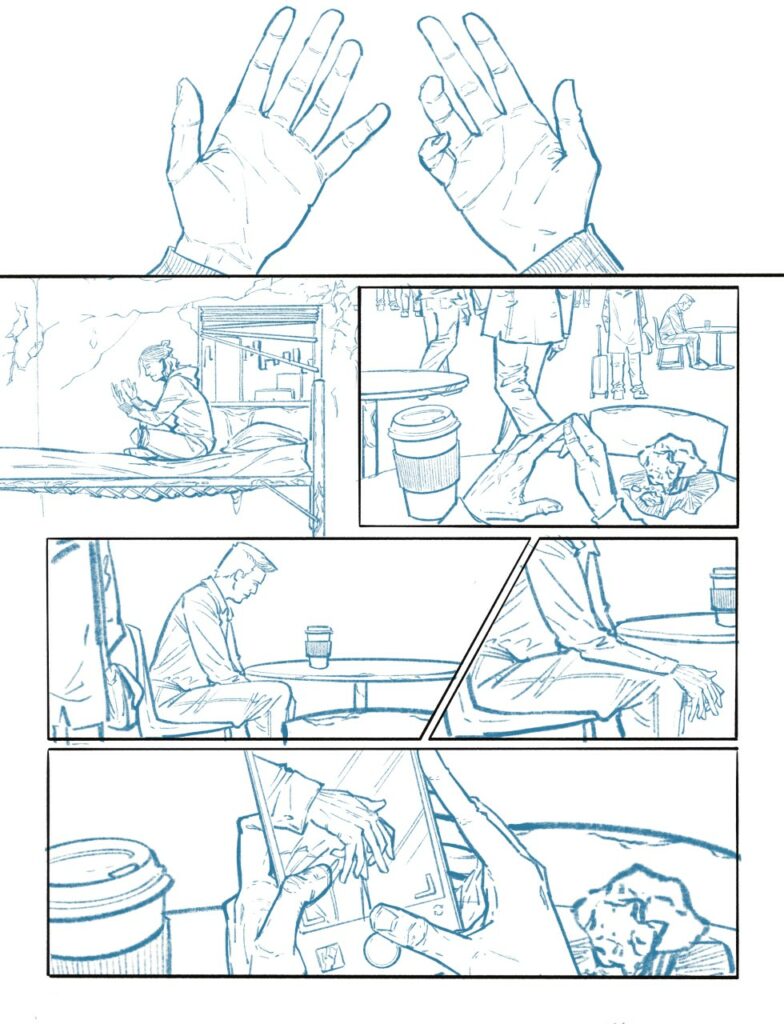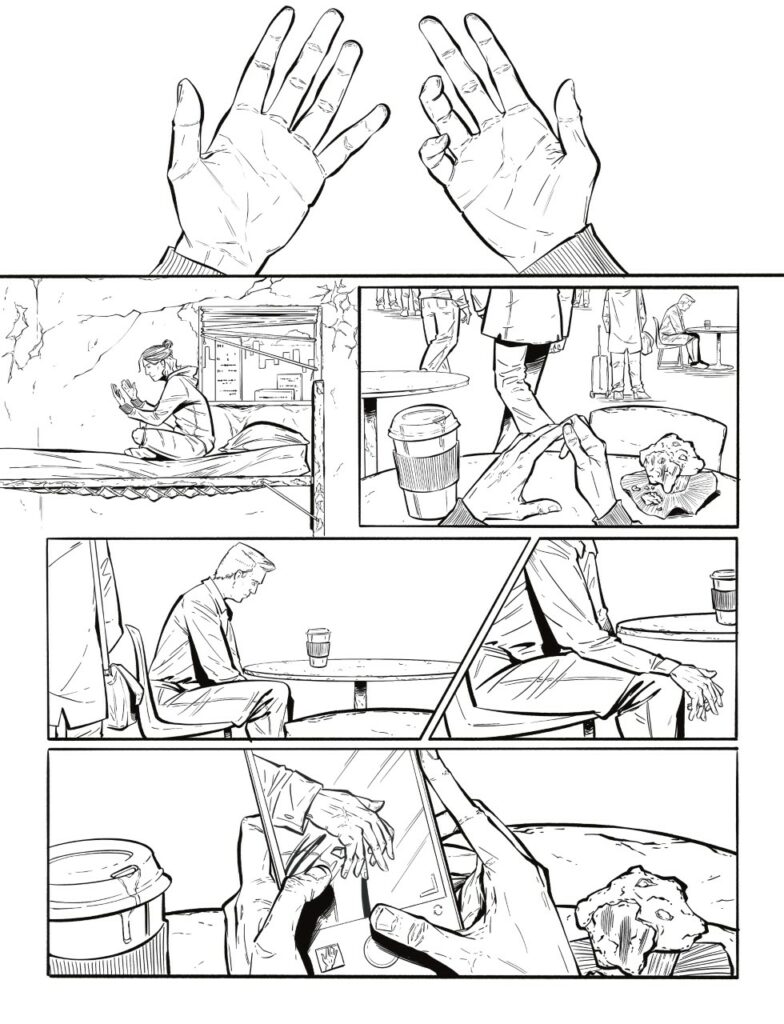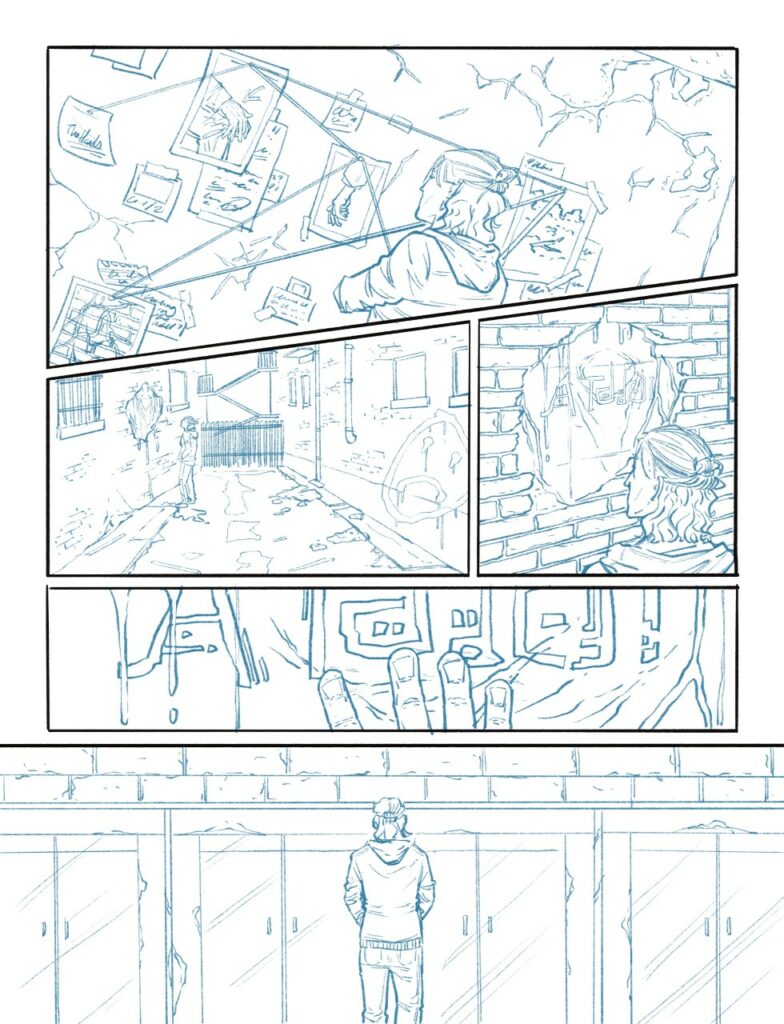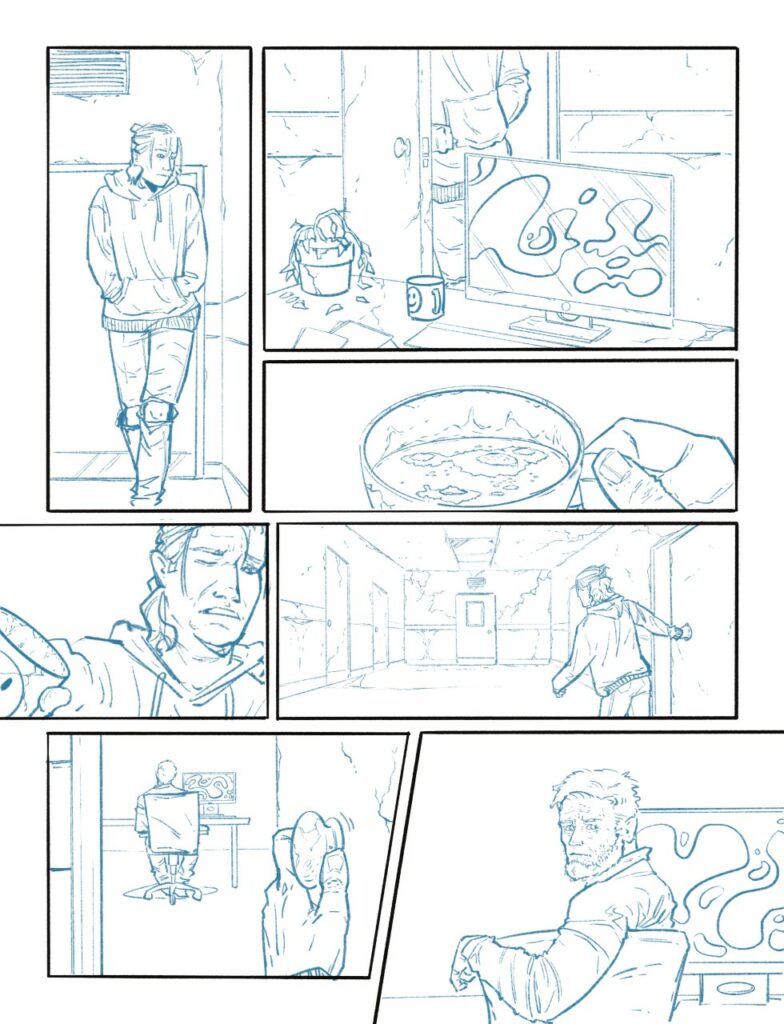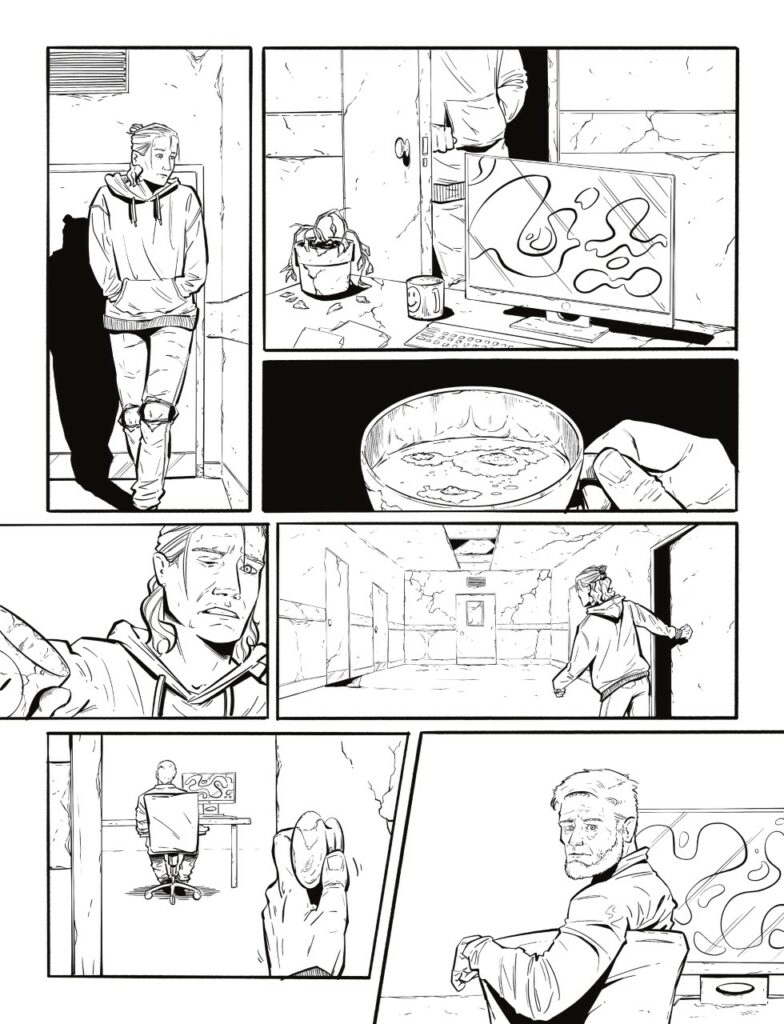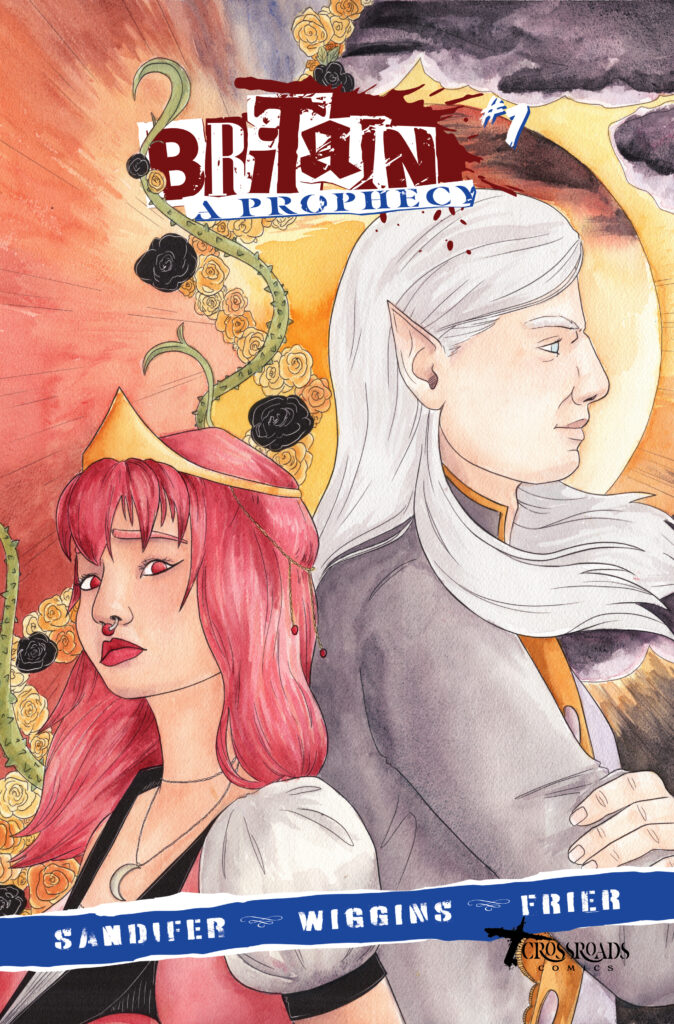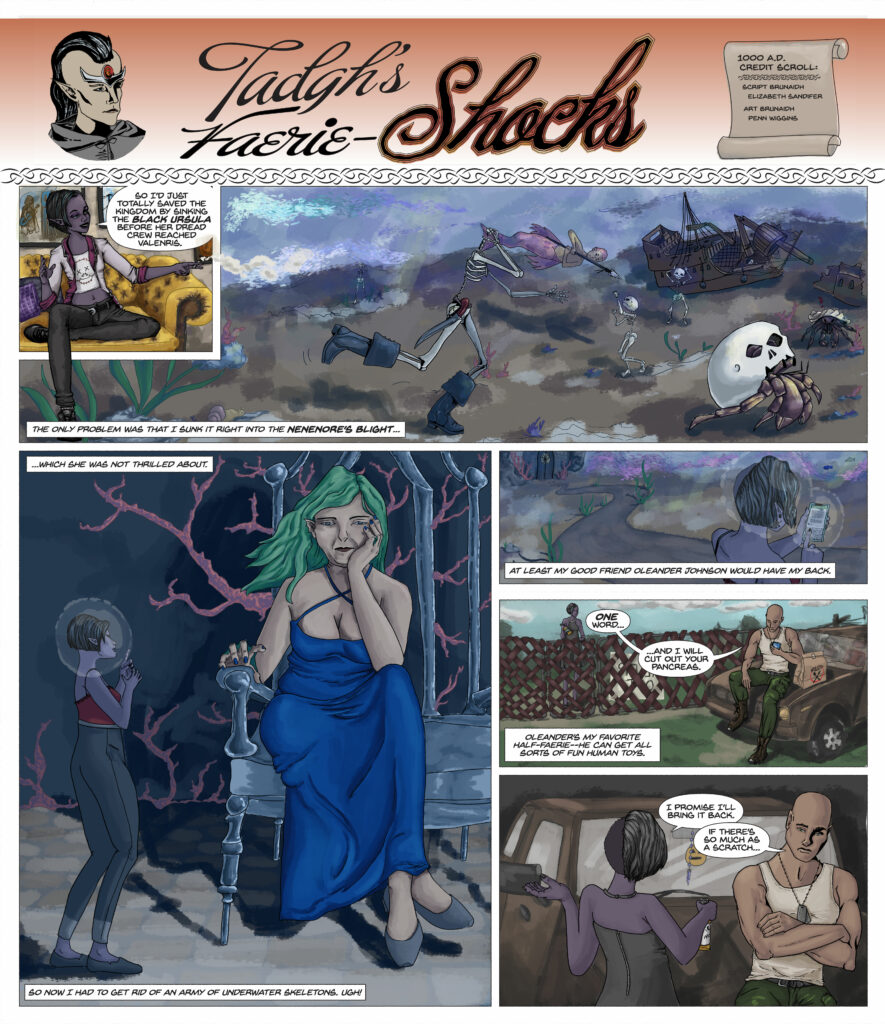Interview: two of Tharg’s newest droids speak out – Elizabeth Sandifer & Laura Helsby on their debut Future Shock
3rd May 2023
In the latest 2000 AD, Prog 2330, out everywhere the Galaxy’s Greatest is sold from 3 May, you’ll find one of Tharg’s Future Shocks from two new droids to the Prog (well, the old ones do wear out with all the punishment TMO throws at them after all.) It’s called Look At Your Hands and is by Elizabeth Sandifer and Laura Helsby.
In just five pages, they tell of a future-ish horror of AI and conspiracy theories, showing what can be done, sparingly, stylishly, with just five pages. It may be Sandifer and Helsby’s first work in the Prog, I don’t think it’s going to be their last by any means!
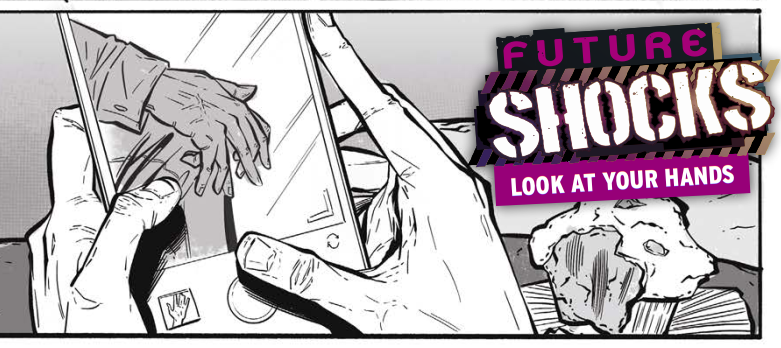
Elizabeth, Laura, you’re the latest new droids that Tharg has deemed worthy of stepping up and getting your names into the Galaxy’s Greatest with your Future Shock: Look At Your Hands appearing in 2000 AD Prog 2330.
So, the first question really should be just what does it mean to you to get yourself published in the Prog?
LAURA HELSBY: Everything! It’s a dream come true, honestly. I know that may be a tad cliché but it’s true, I’ve been a fan of 2000 AD since I can remember. As most comic creatives are, I’m a huge Dredd fan and so it’s really an honour to contribute to such an important publication. 2000 AD have always been the best example of what British comics can be, and to have such talent in their ranks too, I feel humbled. To be able to follow in the footsteps of such Future Shocks alumni as Neil Gaiman and Grant Morrison… well, need I say more?
ELIZABETH SANDIFER: Yeah, I mean, exactly what Laurz said. Even my non-comics-reading American friends understand the weight of a sentence like “My professional break is on the same feature Alan Moore broke in on.” It’s a huge honour, but it’s also something of a statement of intent.
And of course, the second question should be just what is Look At Your Hands all about?
ES: It’s about a woman who starts seeing creepy AI-generated hands in the real world, tries to find out why, and to her horror does so.
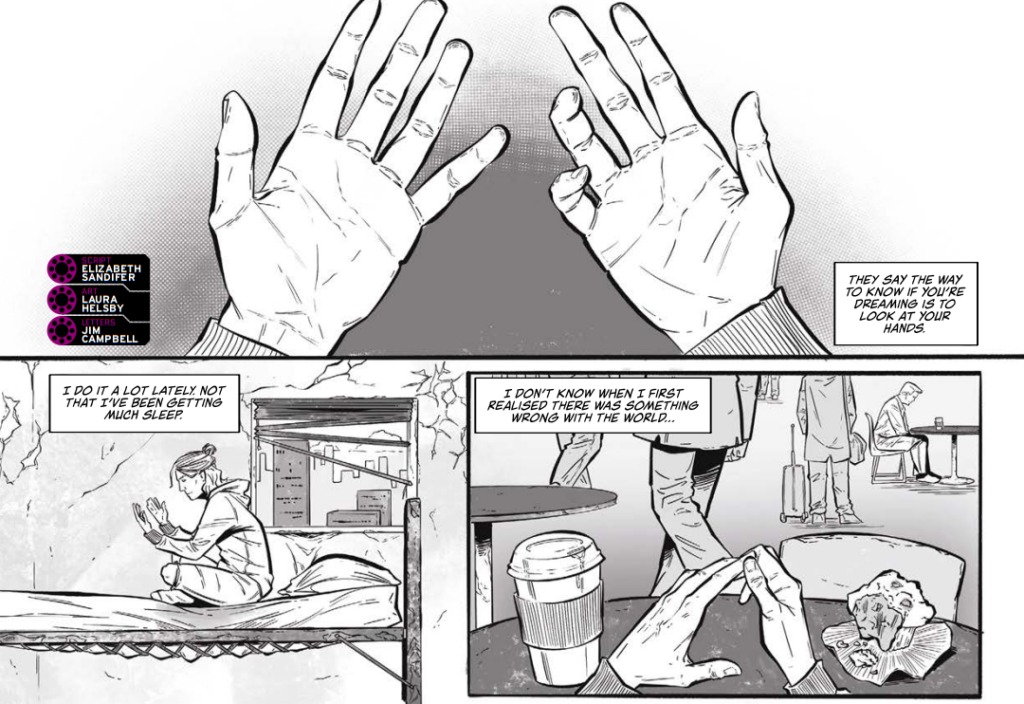
I have to say, I really enjoyed this particular Future Shock – one of several recently that have really worked.
ES: Thank you!
LH: Ditto, that means the world.
It’s definitely following a long line of Future Shocks taking their inspiration from real-world events, mixing a familiar trope of ‘I know there’s something up with the world and the people’ and then mixing in current questions about AI art – in particular just how badly it deals with fingers.
I imagine there are quite a few FS writers out there cursing you for getting in with the first story referencing AI’s bizarre hand problem!
So, was it something that was spurred by recent thoughts on AI art in particular or was that merely a useful hook to put the story on?
ES: It started largely from the visual hook. I just thought it would be fun to make a real artist draw AI hands, and started trying to build a story out from it. Which, that’s a pretty specific image, and so it makes a lot of the decisions for you, especially if you try to avoid the obvious things like “evil AI” or “we’re all living in a simulation.”
In terms of big ideas, it’s probably less about AI art specifically than a larger set of big angry thoughts about the cheapening of art and the devaluing of human artistic vision that comes with its production under capitalism, of which AI art is merely one of the most literally dehumanizing symptoms. I am very fun at parties.
LH: Of course, El is the brains behind the story, and she did such an incredible job, just wanted to say here that I hate AI Art, in as far as it’s non-consensual theft of artists’ work. And that is something I’m very unapologetic and passionate about, and that was one of the reasons I was SO into the story, as well as an excuse to draw hands a lot, and to hopefully be in 2000 AD of course!!!
Laura, I think you’ll find that all fans of 2000 AD are with you on the whole AI art and the exploitation of artists to farm the images. There’s only one being who should be benefiting from the work of his artists and we all know who that is.
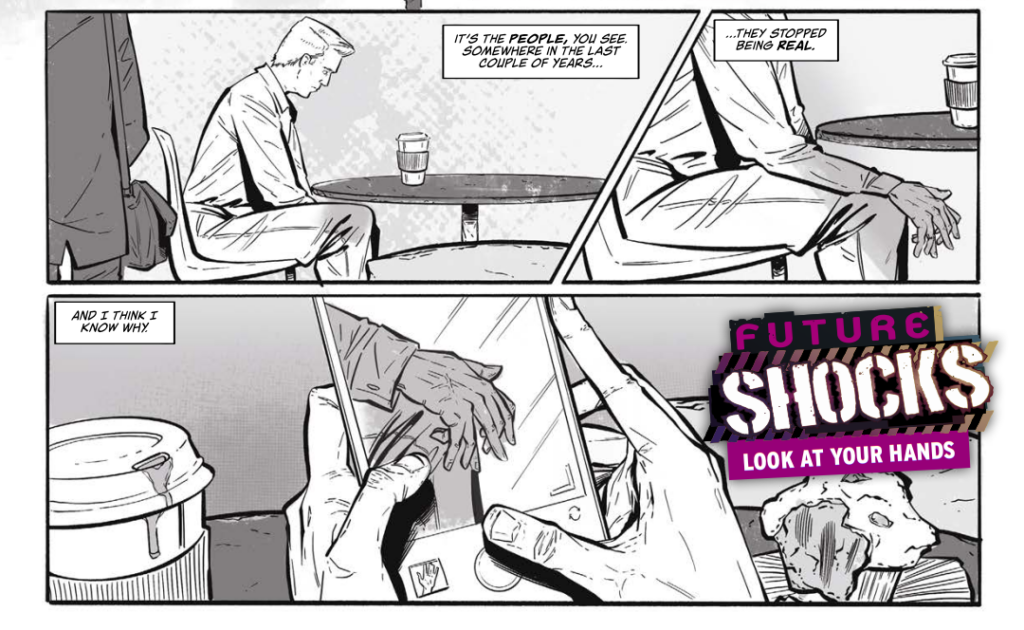
How did this one come about? Did you know each other already and pitched it as a complete thing, writer with artist attached? Or was it all arranged through Tharg with Elizabeth pitching the script first?
ES: It was arranged with Tharg after being loosely pre-arranged between us. I thought of Laurz pretty early in developing the idea; we’d met back at Thought Bubble in November, and I’d absolutely adored their work. It immediately put me in mind of that lineage of ultra-clean British artists – people like Jamie McKelvie, Dave Gibbons, or Mike White who just always offer crystal-clear storytelling. But with a really nice punk grit to it that just made me immediately desperate to work with them. I remembered them tweeting about how much they love drawing hands, and for that matter about how much they hated AI art, and thought “well, talk about the right person for the job.” So I reached out to them and asked if they’d like me to pitch their name as a possible artist. Which Tharg proved amenable to.
LH: Yeah it’s just like El said, I was tabling at Thought Bubble when El approached my table and was such a sweetheart, gave me a bunch of her amazing comics and the rest is history, she reached out about a possible opportunity via a pitch to make a short for 2000 AD and, how could I say no??? Working with a brilliant writer on a story I’m visually and mentally stimulated by, and to top it all off, the chance of being an art droid for Tharg!! No brainer. I was really just very lucky El thought of me for the story and suggested me when pitching it, very thankful to her for it, it’s one of my proudest moments in comics thus far.
ES: Yeah, it’s hard to say no to an infamous galactic conquerer like Tharg.
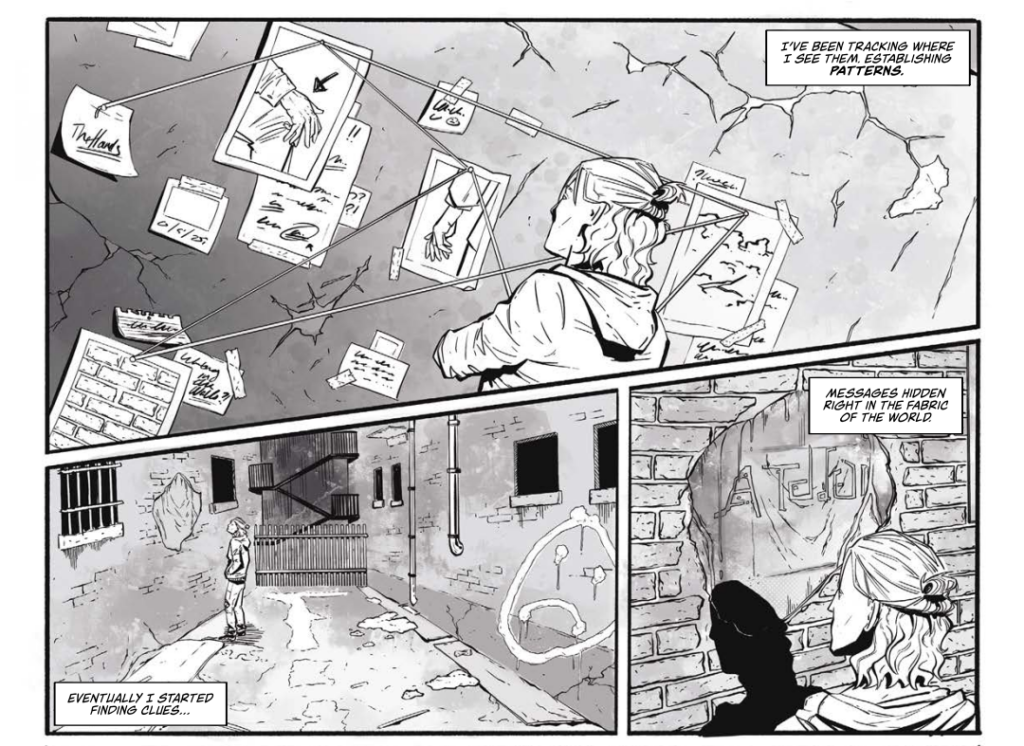
It’s a truth universally acknowledged that it’s so difficult to set up a great Future Shock in just four or five pages, but we’ve seen a fair number done quite perfectly recently – this one included.
What do you think of the FS format, is there a specific mindset you have to get into for such concise storytelling?
LH: I bloody love it! I adore short stories in comics, most people who know me know how much I love punk music and culture, and to me, short stories are the comics equivalent of a punk song, short and punchy! Like BAM! Right in your face and gone before you know it, but you (hopefully) can’t get it out if your head all day. I don’t know if the mindset is much different for me for a short as it is for a full issue or multiple issues, apart from the fact that because I know it’s gonna be over way sooner, I sorta throw myself into it more, like really smash right through it.
Also, I love Future Shocks in as far as they can often help introduce new talent, it’s a wonderful ongoing feature from 2000 AD that I’ve always loved, and right now, am particularly grateful for.
ES: It’s weird, because on the one hand, for all that it’s quite short, it’s enormously flexible. “Five pages, twist ending.” Y’know, that’s very good. You can see why there’s nearly fifty years’ worth of material there. But the flip side of that is that there’s nearly fifty years of material. It’s a format that’s been very extensively explored. And so you have to have a really clear idea of what you’re doing. It’s less, I think, that it’s hard to be that concise than that it’s hard to be that laser-focused. If you’re not crystal clear on your idea and what you want to do with it, you will absolutely be found out by the format.
One thing that you both do here, really well, is tell a huge tale sparsely – simple storytelling, minimal captions, one person’s introspective thoughts on what’s going on with the world that leads, logically and perfectly, to a revelation that not only is there a ‘vast conspiracy that operates the world,’ but that this one questioning soul has found it/them.
Similarly, Laura, your art style here has that same simplicity to it, a thin, lightweight line that focuses on the characters, our foreground for the most part. Backgrounds are simple, if there at all. But when it’s called for, particularly when there’s panel-to-panel transitions that jump in time, such as on page 2 where you both summarise, again so simply but so effectively and sparingly, how our seeker’s investigations have led to this moment in time, you really push the backgrounds to get that story flowing so well.
LH: Thank you, that really means a lot. I tend to use backgrounds very sparingly where I can, I don’t like to clutter the panels too much, and it puts all our focus on to the key element in the frame. Also, I just think it looks cool, so I do tend to only use more extensive ones when setting a scene.
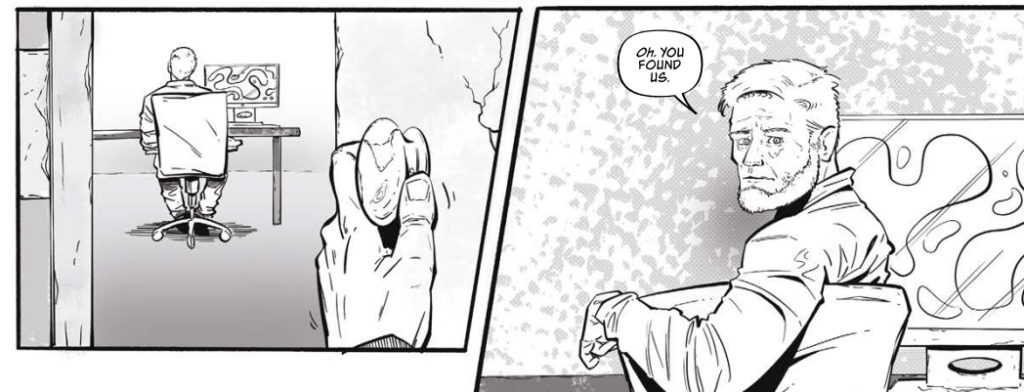
Can you both talk us through your thought processes of putting it together and the stylistic choices you made?
ES: For my part, I found myself thinking that the Future Shock really lends itself to horror as a genre—as do AI hands, really. A lot of my favorite Shocks—I’m thinking stuff like Alan Moore and Jesus Redondo’s “Ring Road” or Grant Morrison and John Hicklenton’s “The Invisible Etchings of Salvador Dali” – make great use of a tight individual perspective and an unreliable narrator, so that the twist ending works as an awful truth sprung on character and audience at the same time. And I thought that individual perspective would help us get away with what are, as you note, some pretty big swings in terms of reveals. To be entirely pragmatic about it, you can get away with a lot less exposition if your narrator doesn’t understand what’s happening.
LH: When I was roughing it out, I just really wanted to give this story some grunge, something gritty. I wanted it to look real, and yet, at the same time, very not real, if that makes any sense, I wanted to visually get across the idea that something was wrong in this world, but through the WAY it was drawn as much as what was drawn.
ES: Which I love, by the way. There’s a bit of splatter at the lip of the coffee cup on page one that just turns my stomach slightly every time I see it, and it’s absolutely perfect. And don’t get me started on your astonishingly gross moldy teacup on page three.
Just for Elizabeth, a chance to revisit those stomach-turning moments from Laura’s art…
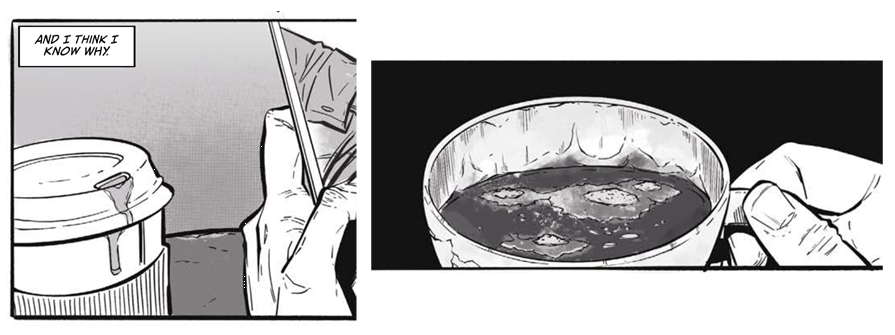
Laura, following on possibly from that one, can you talk us through your process in getting from script to page?
LH: My process is probably pretty standard, I like to read through the script a good few times to really familiarize myself with the story. Usually, it’s on the first pass through the script where I start to visualize some panels in my head, I’ll get really excited about the idea of it and it’ll be pretty fully formed in my head even at that first exposure. For example, the third panel of page one, I love the first-person perspective shots of this story and they instantly inspired me. Everyone who knows me knows how much I adore drawing hands, they just hold so much energy and emotion in them, so panels where hands are the focus, are my favourite and I get very excited to draw them.
Next, is thumbnails, one of my fave parts about short stories, I really get to have fun and just chuck it all out there and see what sticks. Not everything will work, and that can be frustrating sometimes, but that’s all part of the job. I was so excited for this story that I thumbed out the story very, very quickly.
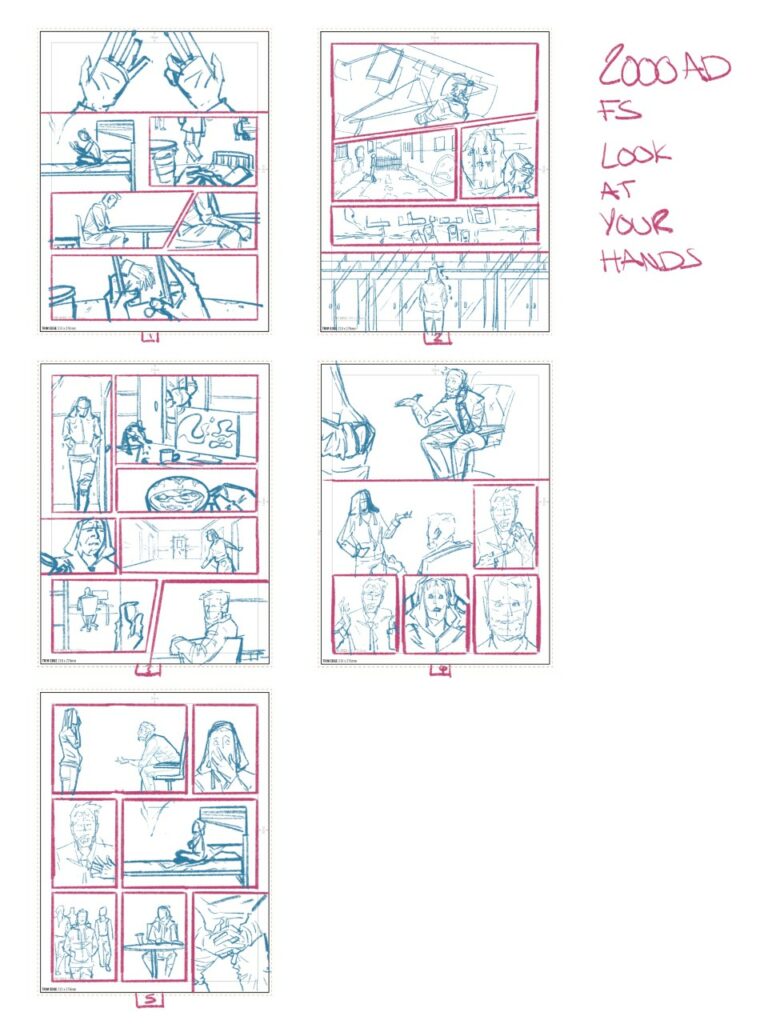
LH: Lucky me, everyone liked the thumbnails so then I go straight to pencils, I scale up my rough and use it like inkers use pencils beneath, as a guide. Here’s the thing about my pencils, they’re tight, like, probably too tight haha! I make more work for myself than is necessary I guess, my mates always say they could be finished inks. I just like to have everything definitive for when I get to inking.
.
LH: Speaking of the glory that is inks, that’s next up! Now my pencils are nice and refined, there’s not much thinking to be done, it’s all there for me, I can just let the lines flow and the line weights can just naturally decide themselves, I find that the less I think too hard about how I’m inking, the better. Empty head, only inks.
.
LH: And then we add the grey tones! This isn’t something I do a lot, but we felt it would benefit the look of the story, give some texture and grit, like I mentioned earlier. This is just lots of experimenting to see what works, which tones, which brushes and textures, if there should be a gradient or some noise, it’s all just playing around, I think it looks pretty cool though, so I’ll be using greys more in the future for sure!!
Now, moving away from the Future Shock… as you’re both new to 2000 AD, can you tell us a little about yourselves?
LH: Well obviously I’m a comics artist, ha, but I’m mostly known for my inking style, my lines, as well as the fact that I LOVE drawing hands,.. and clothes, the folds are just so fun! I love doing both covers and interiors, I especially dig gigs that feature punk and music generally, Queer or political themes. I’m very politically minded, or invested rather, I want to abolish the monarchy and get rid of the Tories, that should tell you enough haha.
I also play guitar and video games, a lot, maybe too much? Nah, never too much! I collect vintage vinyl and cassette tapes, and I love basketball, like to shoot some hoops in my spare time. OH! And I’m addicted to tattoos!
ES: I’m mostly established as a critic – the thing that’s most relevant here is probably an ongoing project called Last War in Albion that’s a history of the Alan Moore/Grant Morrison rivalry that treats that feud as a magical war for the soul of the 21st century. But over the past few years, I’ve been moving into fiction writing. Beyond that, I spend too much time on Twitter and have a horrible but delicious tendency to cook over-elaborate meals.
You’re both UK based, am I right?
ES: I’m actually an American interloper. You took over our comics industry in the 80s, now I’m coming for yours.
LH: Yessir! Manchester born and raised.
ES: I’m glad one of us has authenticity or credibility.
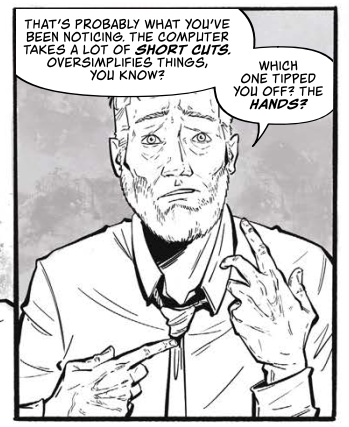
When did you first discover comics? And what was it that really got you into the medium?
EH: That would have been in, like, 1991 or so when the first series of Marvel Trading Cards – the ones with a ton of Mark Bagley and Art Adams art – were the big fad in school. And so I got into them, and, because I was an absolute dweeb, just completely overshot cool and became a comics nerd who was still into it three months later when the rest of the playground had moved on.
LS: Hmm, it’s hard to pinpoint it, I used to read things like the Beano when I was absolutely tiny, but as I started to grow I remember one trip to the beach when I was around 6 – before we left for home we visited a gift shop, it was also a newsagents and they had a spinning rack of comics, I think the bag had two in. And I read it on the way home, it was Batman: Black and White: An Innocent Guy. Might have been a little young for that issue, haha, but it got me. I was hooked, I got home and got straight to trying to draw the panels from the book myself, I still have those somewhere.
At what point did you decide that comics were something you were interested in pursuing professionally?
LH: When I was 15, we had to put an aspiration in our High School leavers yearbook, and I just instinctively put “comic book artist.” Guess I was right huh!
ES: Surprisingly late. It was always something I thought idly about, but I only actually took a serious stab at it a few years ago when my husband Penn Wiggins, who’s an artist, basically went “hey, I’d like to try drawing comics, would you write me something?” So I turned out… actually, what I did was a five pager that pastiched Future Shocks into Tadgh’s Faerie Shocks and did a twist-ending fantasy story. And it turned out we quite liked doing comics, so we turned out a few shorts, then moved on to self-publishing an ongoing fantasy series called Britain a Prophecy, and got enough buzz with that to catch Tharg’s eye.
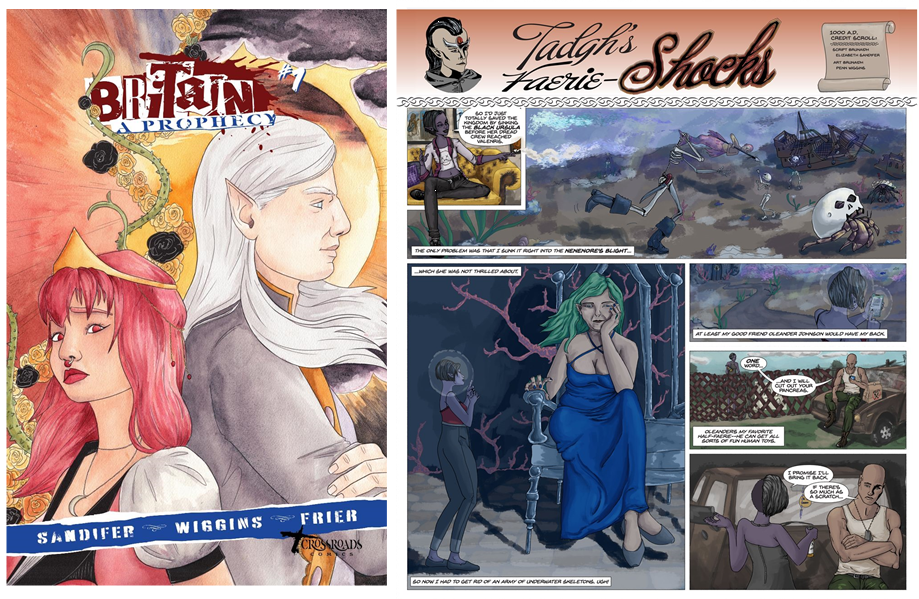
– art by J. Penn Wiggins – full-sized versions to be found at the end of the interview)
A few old chestnuts here to end with as well… what/who influences your work? Any specific writers/artists/works that triggered a desire to work in comics?
LH: There’s so many! Dave Gibbons was one of my first real inspirations, I read Watchmen at an early age and just adored his work, luckily met him too, very nice guy. I love David Aja’s work a lot, as I started to make comics, I really became inspired by his lines and his perspective and composition of his shots. But to reel off a few, I adore artists like Chris Shehan and Skylar Patridge, they both have such grit to their work, in different ways, but it’s there, there’s texture, substance, and of course, they’re both just incredible artists, and wonderful people.
ES: As a couple of my answers have probably revealed, despite being an American I’ve always had a real love for the British scene – that whole tradition from Alan Moore and Neil Gaiman up through people like Warren Ellis, Kieron Gillen, or Al Ewing. I’m very much the 90s kid whose Sandman trades were among her prized possessions.
As for 2000 AD, were you aware of the comic growing up or was it something you came to later in life? Any particular big entry point for you both that turned you into fans?
ES: Later in life for me, when I was doing some research into Alan Moore and Grant Morrison’s early years that became Last War in Albion, and so started reading their stuff, then the larger magazine to understand the context – I basically just read the first five hundred Progs or so back to back. I think the point where I was firmly a fan was Shako. There’s a kind of mad thrill to “the only bear on the CIA death list” as a sentence that has literally never left my head. Really, Pat Mills in general made an impression. There’s a beat in “Invasion!” back in Prog 1 where he quietly has a Margaret Thatcher stand-in get publicly executed in the midground of a panel that was just very inspirational in its ostentatious and defiant directness. You can pour over American mainstream comics of the 1980s but you never really see Reagan take a bullet to the head as a throwaway gag, y’know?
LH: I was aware of the Prog from an early age, once I’d gotten into comics beyond the Beano I started to branch out and 2000 AD always appealed, I mean, look at it!! It’s cool as hell! Like I said earlier, I’m a Dredd fan, I can’t remember the first Dredd story I read but the bold black and white inky art definitely left its mark on me! Mick McMahon cursed me to be a black-and-white artist! (Cursed in a good way, I’d have it no other way!!)
ES: Oh, man, McMahon. Absolutely classic pick there.
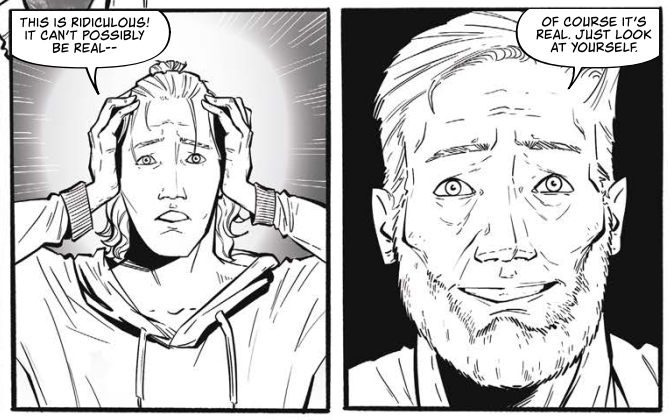
And as far as getting published here for your Future Shock, has it been the usual story of submit, get rejected, submit again, rejected again, submit again, etc. etc. or was this a case of Tharg seeking you out to feature in the Prog?
ES: I met Tharg at Thought Bubble, where he was unconvincingly disguised as a human named “Matt Smith,” and was given the green light to pitch. Look At Your Hands is my second one, and was accepted pretty straightforwardly. The first one, which should show up soon, went through one round of revisions before Tharg took it. So reasonably straightforward.
LH: El was the lead on this one, and I’d never pitched to 2000 AD before, so this was actually a one-pitch winner for me! Which was a wonderful feeling.
Oh, a straightforward pitch for two Future Shocks with no rejections, just revisions for Elizabeth and a one-pitch winner for Laura – lots of writers and artists are really clenching their teeth right now!
Have you seen the finished work yet or is that something you’re looking forward to? Maybe a celebratory trip to the local newsagent to see it on the shelf there?
ES: One of the nice things about being a critic is that you know many disreputable people who get “review copies,” one of whom nicely slipped me the PDF, so I have seen it. Which is good, because I tragically don’t think my local shop carries rack copies of 2000 AD.
El, do send us the name of the owner, Tharg has a nice job for Mek Quake.
LH: El sent me the preview PDF from her pal, so lucky me I got to see it in all its glory, with Jim Campbell letters !! THE Jim Campbell, I was very happy to see his name on the credit cards, he’s a legend. To be honest I got a little teary-eyed when I opened the PDF to see our names in the intro by Tharg, being called a debuting droid… now that’s special to me, as a 2000 AD fan, that’s special. But you can be sure I’ll be at the local shop trying to find it, I can’t wait to point to it on the rack and say “I made art that is in there” that “I did that” feeling, I can’t wait.
ES: I got that PDF while I was out at dinner, and literally *squealed* to see that we’d gotten Jim on letters. Penn, who’s really taken to lettering on top of art, was insanely impressed. I think slightly more so than he was that I got the damn thing published, actually.
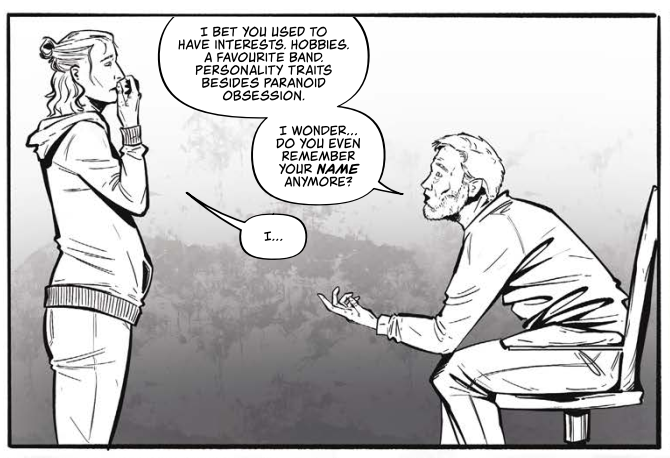
Finally, a chance for you to push whatever else you have on the boiler right now… what can we expect to see from you over the next few months – either for 2000 AD or elsewhere?
LH: Well I am working on something right now but that’s in veryyyy early development, it’s music based and it’s written by the amazing Dave Cook, I’m very lucky to be working with him. I’ve also got a mini-series coming out late this year, if all goes to plan, by Devils Due Comics, called The Claims Adjuster, written by Chuck Satterlee, and on top of that; lots of shorts in anthologies and covers too! I’ll have all these and more at my table at Thought Bubble comic book convention in Harrogate UK in November of this year, so if anyone reading wants to, please stop by, have a chat and just a generally good time. Cheers!!
ES: Well, like I said I’ve got another Future Shock in the pipeline, and another pitch on Tharg’s desk. Most of my work is on my Patreon —my current critical project, which is an episode-by-episode series of essays on the Jodie Whittaker era of Doctor Who, along with Britain a Prophecy and ebooks of all my past projects, Last War in Albion included. I’ll be dropping a big behind-the-scenes deep dive on Look At Your Hands there as a higher-level reward soon. And I’ll be at Thought Bubble, probably making any excuse I can to ditch my table and head over to Laurz’s to be like “hey you wanna go pitch a D.R. and Quinch revival?”
And with that idea of a DR & Quinch revival teasing us, we bid farewell to Elizabeth and Laura. They’re two new droids with a huge future in the Galaxy’s Greatest ahead of them we’re sure. And thanks so much to them both for talking to us, it was a real pleasure.
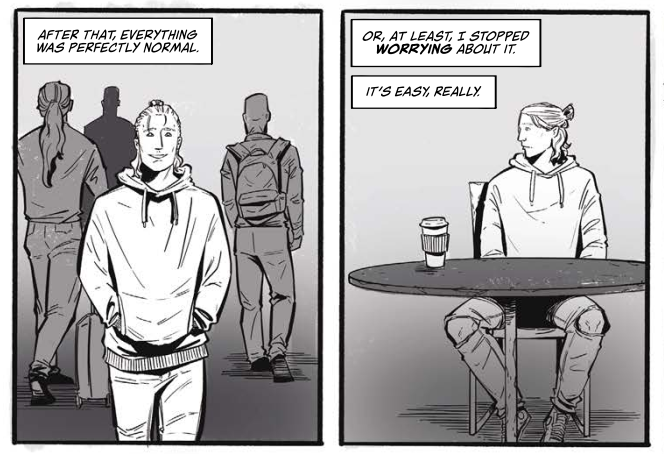
You can see the fruits of their labours, Look At Your Hands, in the pages of 2000 AD Prog 2330, out everywhere the greatest comics are sold, including the 2000 AD web shop.
You can find links to all Elizabeth’s work, including the fascinating Last War In Albion, right here, and all of Laura’s links right here.
Finally, the full-sized art we promised you with Laura’s pencils and inks from the Future Shock and those two pieces of Elizabeth’s comic work…
